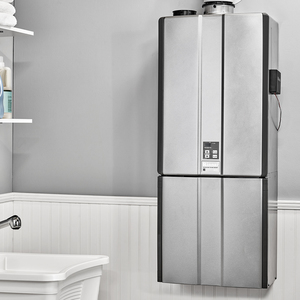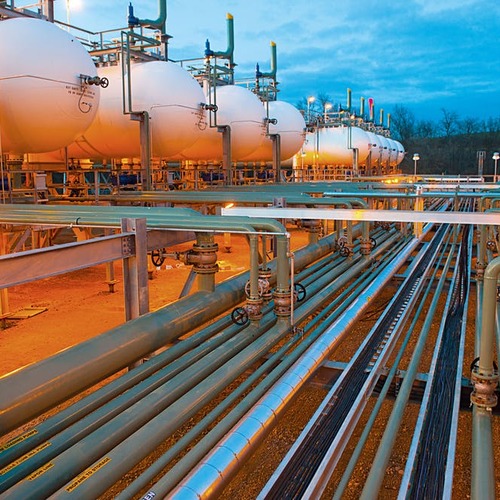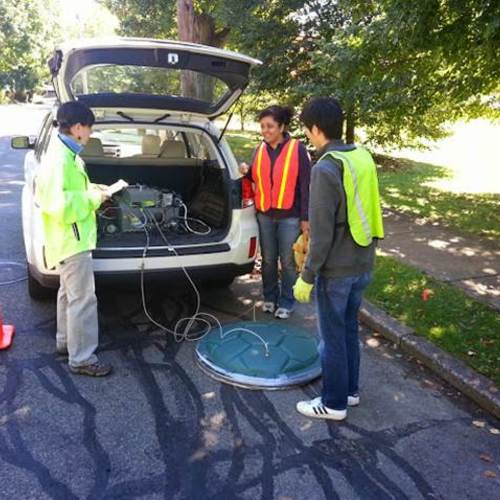
A limited study in California provides one more reason to ditch the gas kitchen range and convert to electricity.
Researchers estimate that the more than 40 million gas stoves in U.S. kitchens emit significant amounts of methane even when they are turned off. Methane is a major component of natural gas, 86 times as powerful as carbon dioxide for global warming when measured on a 20-year timescale.
The study, published in the journal Environmental Science & Technology late last month, measured the methane released by kitchen stoves in 53 homes. The Stanford University researchers measured leaks when the stoves were off (what they called “steady-state-off”), when the burners were on, and in the transition periods when burners were being ignited or turned off. Between 0.8% and 1.3% of the natural gas that stoves use in all is emitted as unburned methane, adding up to total U.S. emissions of 28 gigagrams (Gg) of methane annually.
“More than three-quarters of methane emissions we measured originated during steady-state-off,” the report says. “Using a 20-year time frame for methane, annual methane emissions from all gas stoves in U.S. homes have a climate impact comparable to the annual carbon dioxide emissions of 500,000 cars.”
In addition to methane releases, stoves also produce nitrogen oxides when stove top burners or ovens are on, which can trigger respiratory disease. In fact, households that do not use range hoods or have poor ventilation can exceed the national standard for nitrogen dioxide with just a few minutes of stove use, especially in smaller kitchens, the report says.
The report comes at a time when cooking and heating appliances that run on natural gas and other fossil fuels are already in the crosshairs in a number of U.S. and Canadian communities as regulators look for ways to slow global warming. More than 20 cities in California, including San Francisco and Berkeley, have passed laws that would prohibit the use of natural gas in new buildings. Earlier this year, New York City got on the bandwagon with a ban on gas connections in new buildings, joining cities in Massachusetts and Washington. In Canada, a requirement for zero-emissions space and water heating went into effect on Jan. 1, in Vancouver, and Quebec outlawed oil-fired heating equipment in new construction at the start of the year.
However, at least 20 states, including Arizona, Georgia, Florida, and Texas, have passed laws that prohibit gas bans. The gas industry also has fought the restrictions, and gas ranges remain popular with many cooking professionals.
The researchers, all from the Department of Earth System Science at Stanford University, said that natural gas leaks from the 3 million miles of pipeline in the U.S. have been studied extensively. But much less work has been done to understand gas emission inside houses, what they called “post-meter emissions.”
Emissions from gas stoves are an especially ripe area for research. More than one-third of all U.S. households use natural gas for cooking. In California, 60% of all households cook with gas.
“Among all gas appliances, the stove is unique in that the byproducts of combustion are emitted directly into home air with no requirement for venting the exhaust outdoor,” the report says. “In fact, some kitchens have ‘ductless’ hoods that recirculate fumes through activated charcoal filters, which are generally less effective at cleaning the air.” Range hoods vented to the outside are more effective, but they are used only 25% to 40% of the time.
Researchers measured emissions in private homes, homes for sale or rent, and in Airbnb rentals, and studied both gas cooktops as well as ovens and broilers. Stoves ranged in age from 3 to 30 years. Results suggest that “most stoves and associated nearby piping leak some methane continuously.”
Methane emissions from a single burner during combustion were more than four times higher than when the entire stove was turned off, but the length of time during the day when burners are idle is much longer.
Other findings:
- Emissions from one on-off pulse for a single burner equaled the amount of gas emitted during 10 minutes of steady combustion.
- Burners lit with an electronic sparking device emitted less methane than cooktops with pilot lights.
- The age and price of the stove did not affect methane emissions.
The authors said they quantified steady-state-off emissions from stoves because they had not been included in most previous studies of cooktop emissions, and because previous research had found that steady-state-off emissions were a “substantial, sometimes dominant” component of total methane emissions from tank-style water heaters.
Scott Gibson is a contributing writer at GBA and Fine Homebuilding magazine.
Weekly Newsletter
Get building science and energy efficiency advice, plus special offers, in your inbox.















14 Comments
Want to find another source of methane leaks with in a home? Try the regulator on gas furnaces.
...or your sewer lines.
The study does aim at highlighting an important and fixable issue as to leakage.
In Table 1 of the supplemental materials (listing units and brand), "NO OVEN" means that the oven was electric. It appears that four of the 53 units had a price above $3,000 and in emissions versus age, outliers are apparent, which are likely faulty units (two worst, under $1,000). In Fig. 2A (steady state off), the curve levels (log scale) at about 0.05 g/hr (50 mg/hr) (approx. 438 grams per year, which is ~0.44 kg per year).
Per UC-Davis, a single cow emits 100 kg methane per year by belching (220 lbs). So, in Fig. 2A, steady state off methane from stoves in 227 homes = 1 cow. The US has about 100 million cows = 22700 million homes. In reality, the US has only 120 million households.
Methane emissions is an issue, glad I don't have a cow in my house; noting that humans output around 50 grams of methane per year from breathing alone (Max-Planck). So, a family of four is emitting about 200 grams of methane per year in their breath (about half of steady state off of a "good" stove).
Human (via breath): 50 g/yr (~300 million in US)
Stove (steady state off): 438 g/yr (~120 million in US)
Cow (belching): 100 kg/yr (~100 million in US)
Stove/home fixes: better valves, more efficient combustion, and adequate ventilation.
..added stove/home fixes...clean the knobs occasionally by removing them and cleaning around the stems to ensure the are closing completely.
Good point ;-)
PBP1,
"Stove/home fixes: better valves, more efficient combustion, and adequate ventilation."
Or do as these jurisdictions are and phase out combustion appliances in homes. I agree it's important to put these emissions in perspective, but each sector of the economy can only deal with what it has control over, and I think builders should take some responsibility, even if they don't have any say over farming practices.
Agreed that each industry should take care, especially with science/fact - GBA and its experts are helping in that regard.
I'm still reeling from the ignorant and politically motivated people (many on the taxpayers' dollar) that said SARS-CoV2 wasn't airborne, as I bow down to the aerosol scientists. And, even some of those aerosol scientists are now looking more closely at home environments and all energy/chemical/material sources/sinks wrt air/contaminant flows. We're making progress ;-)
All that said, I believe safety remains an issue, especially where the grid fails (placing people, animals, buildings at risk, of which I have first hand experience). I look forward to the day when lithium is recycled (less mining) and, perhaps, thin film solar is widespread (more local generation and storage). However, given the antiquated and unreliable infrastructure in the US (where cheap is good and passing costs/problems on to the next generation is even better), grid failures will continue such that ng is likely to remain a backup option for safety (noting that using the word "safe" in that context is certainly double-edged).
This is kinda funny if your numbers are accurate however don't forget to include distribution leaks.
Remember the purpose of these reports is reduce natgas usage down to power generation alone (Multiple emissions points reduced down to "1").
Recent studies (2022) on human emissions:
https://www.sciencedirect.com/science/article/pii/S0048969722023348?via%3Dihub
Methane: about 2 mg/h/person (about 18 g/yr/person)
CO2: about 30 g/h/person (262 kg/yr/person)
https://pubs.acs.org/doi/10.1021/acs.est.1c08764#.YlQ3vWkR4Eg.twitter
Effect of ozone reactions on chemicals emitted by humans
I’m all for being green, but if a SINGLE cow emits as much methane as 227 stoves in American houses over a year why are we worried at all about the minuscule amount of rounding error that gas stoves contribute to global warming? Does the gas line infrastructure going into a house emit 1000 times more methane than the actual stoves? I get that exhaust from a gas stove isn’t great to breath, but is the attention against gas stoves from a global warming standpoint just something to feel good about? Am I misunderstanding something?
Interesting
The magnitude of the differences, IOW how bad the bad ones are compared to many others brings questions. Like maybe defective stoves are pumping a bunch of methane into your house.
I think I would do a lab study of a few generic gas ranges to see what they look like in a controlled environment to establish a baseline to compare
Using the study details, that's less than I kg of methane per appliance. I think I'll take may chances and make sure my valves are in good condition. Props to the author for trying to generate maximum hysteria from the study though. Hey did you know that producing electricity is by far the number one source of carbon emissions in the world? now you do.
Kudos to the author. I always questioned if those easily turnable stove gas valves in the apartment we lived many years ago were actually leaking... We could smell the gas but maintenance would come and state everything is good.
I am sure the situation is different for high end appliances.
Abandoned, uncapped wells are at the other end of the network of gas drilling, gas distribution lines, and end uses. Uncapped wells contribute substantially and continuously.
https://www.reuters.com/article/us-usa-drilling-abandoned-specialreport/special-report-millions-of-abandoned-oil-wells-are-leaking-methane-a-climate-menace-idUSKBN23N1NL
This article also notes the emissions of hazardous chemicals used in drilling that are escaping from uncapped wells (not just global warming issues).
It would be nice to have a good estimate of the percent emissions of methane and other substances from each step in the process, from drilling to end uses in homes and industry. As well as cattle and other sources.
Log in or create an account to post a comment.
Sign up Log in